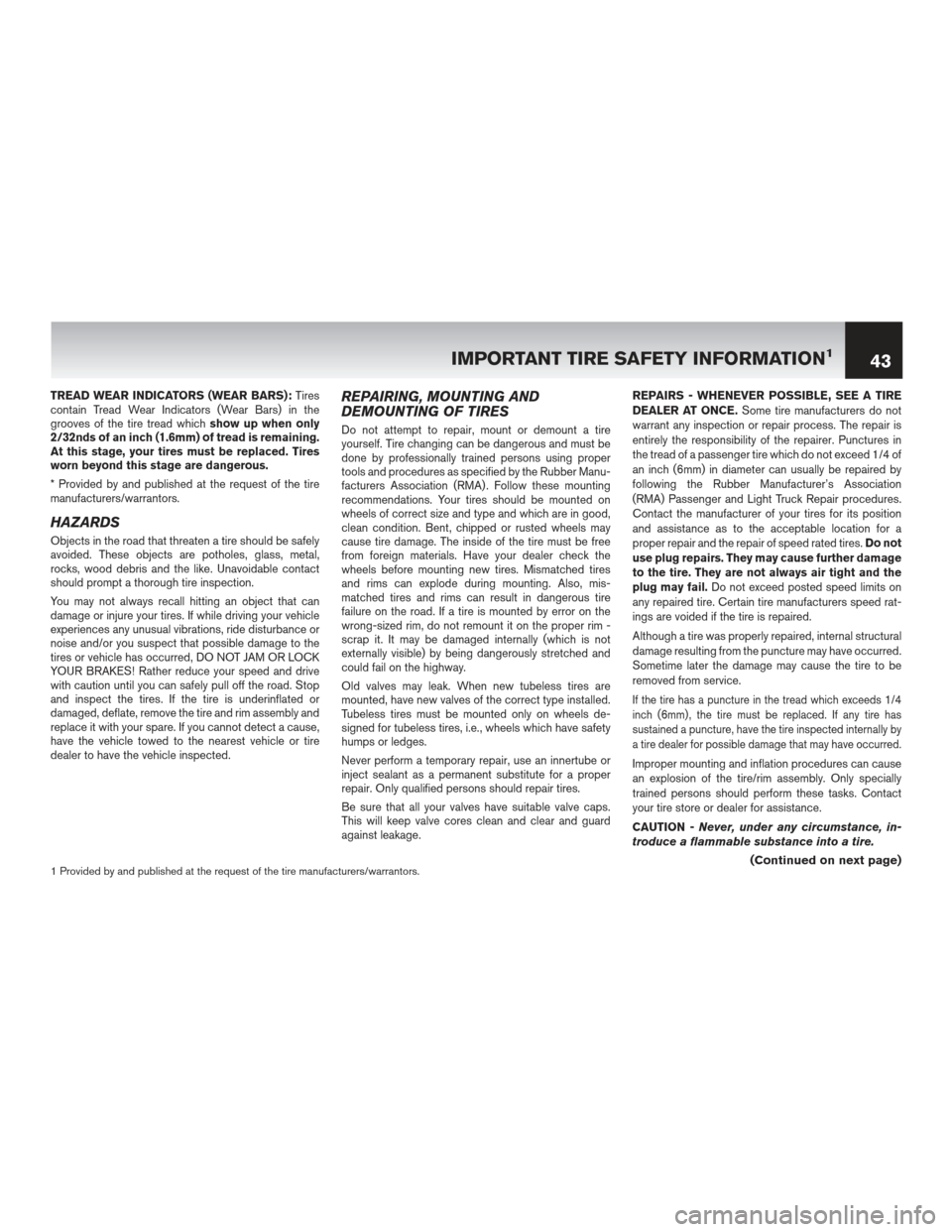tow bar NISSAN SENTRA 2012 B16 / 6.G Warranty Booklet
[x] Cancel search | Manufacturer: NISSAN, Model Year: 2012, Model line: SENTRA, Model: NISSAN SENTRA 2012 B16 / 6.GPages: 61, PDF Size: 0.36 MB
Page 47 of 61

TREAD WEAR INDICATORS (WEAR BARS):Tires
contain Tread Wear Indicators (Wear Bars) in the
grooves of the tire tread which show up when only
2/32nds of an inch (1.6mm) of tread is remaining.
At this stage, your tires must be replaced. Tires
worn beyond this stage are dangerous.
* Provided by and published at the request of the tire
manufacturers/warrantors.
HAZARDS
Objects in the road that threaten a tire should be safely
avoided. These objects are potholes, glass, metal,
rocks, wood debris and the like. Unavoidable contact
should prompt a thorough tire inspection.
You may not always recall hitting an object that can
damage or injure your tires. If while driving your vehicle
experiences any unusual vibrations, ride disturbance or
noise and/or you suspect that possible damage to the
tires or vehicle has occurred, DO NOT JAM OR LOCK
YOUR BRAKES! Rather reduce your speed and drive
with caution until you can safely pull off the road. Stop
and inspect the tires. If the tire is underinflated or
damaged, deflate, remove the tire and rim assembly and
replace it with your spare. If you cannot detect a cause,
have the vehicle towed to the nearest vehicle or tire
dealer to have the vehicle inspected.
REPAIRING, MOUNTING AND
DEMOUNTING OF TIRES
Do not attempt to repair, mount or demount a tire
yourself. Tire changing can be dangerous and must be
done by professionally trained persons using proper
tools and procedures as specified by the Rubber Manu-
facturers Association (RMA) . Follow these mounting
recommendations. Your tires should be mounted on
wheels of correct size and type and which are in good,
clean condition. Bent, chipped or rusted wheels may
cause tire damage. The inside of the tire must be free
from foreign materials. Have your dealer check the
wheels before mounting new tires. Mismatched tires
and rims can explode during mounting. Also, mis-
matched tires and rims can result in dangerous tire
failure on the road. If a tire is mounted by error on the
wrong-sized rim, do not remount it on the proper rim -
scrap it. It may be damaged internally (which is not
externally visible) by being dangerously stretched and
could fail on the highway.
Old valves may leak. When new tubeless tires are
mounted, have new valves of the correct type installed.
Tubeless tires must be mounted only on wheels de-
signed for tubeless tires, i.e., wheels which have safety
humps or ledges.
Never perform a temporary repair, use an innertube or
inject sealant as a permanent substitute for a proper
repair. Only qualified persons should repair tires.
Be sure that all your valves have suitable valve caps.
This will keep valve cores clean and clear and guard
against leakage. REPAIRS - WHENEVER POSSIBLE, SEE A TIRE
DEALER AT ONCE.
Some tire manufacturers do not
warrant any inspection or repair process. The repair is
entirely the responsibility of the repairer. Punctures in
the tread of a passenger tire which do not exceed 1/4 of
an inch (6mm) in diameter can usually be repaired by
following the Rubber Manufacturer’s Association
(RMA) Passenger and Light Truck Repair procedures.
Contact the manufacturer of your tires for its position
and assistance as to the acceptable location for a
proper repair and the repair of speed rated tires. Do not
use plug repairs. They may cause further damage
to the tire. They are not always air tight and the
plug may fail. Do not exceed posted speed limits on
any repaired tire. Certain tire manufacturers speed rat-
ings are voided if the tire is repaired.
Although a tire was properly repaired, internal structural
damage resulting from the puncture may have occurred.
Sometime later the damage may cause the tire to be
removed from service.
If the tire has a puncture in the tread which exceeds 1/4
inch (6mm) , the tire must be replaced. If any tire has
sustained a puncture, have the tire inspected internally by
a tire dealer for possible damage that may have occurred.
Improper mounting and inflation procedures can cause
an explosion of the tire/rim assembly. Only specially
trained persons should perform these tasks. Contact
your tire store or dealer for assistance.
CAUTION - Never, under any circumstance, in-
troduce a flammable substance into a tire.
(Continued on next page)1 Provided by and published at the request of the tire manufacturers/warrantors.
IMPORTANT TIRE SAFETY INFORMATION143